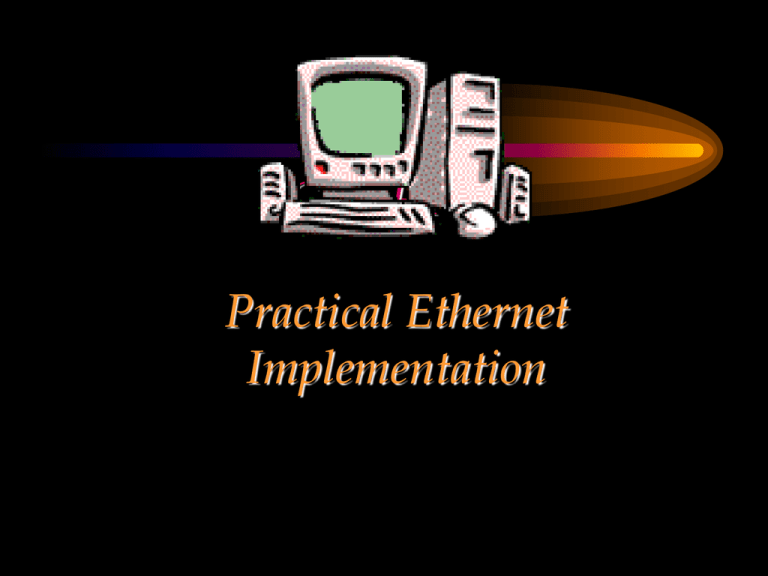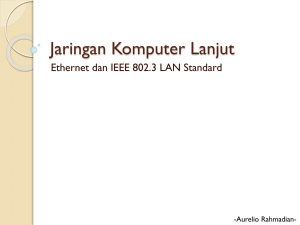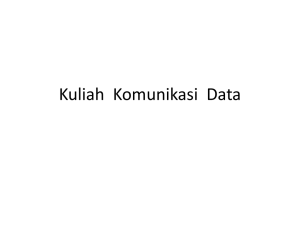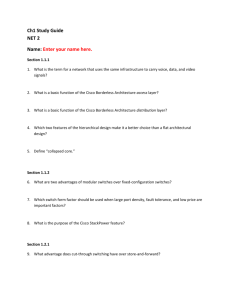
CHAPTER
Practical Ethernet
Implementation
Chapter Objectives
• Provide a background on Ethernet
itself and describe its characteristics
• Explain the practical implementation of
various Ethernet LANs
– 10BaseT, 10Base2 and 10Base5
– Show sample networking devices and
network connections
• Introduce the 100 Mbps Ethernet that is
also known as fast Ethernet
• Discuss the various operating systems
Chapter Modules
•
•
•
•
•
•
•
•
Background on Ethernet
Ethernet Basic Characteristics
Overview of Implementation
IEEE Implementation of 10BaseT
IEEE Implementation of 10Base2
IEEE Implementation of 10Base5
Fast (100 Mbps) Ethernet Networks
Network Operating Systems for Ethernet
Networks
MODULE
Background on Ethernet
© N. Ganesan, All rights reserved.
Module Objectives
• Describe Ethernet in general
• Trace the origin of Ethernet
• Discuss the current status and speeds
Ethernet Defined
• A highly standardized popular network
architecture
• Based on the CSMA/CD transmission
protocol
• It is a logical bus network that is
implemented both as a physical star
and a physical bus network
• Governed by the IEEE 802.3 standard
Origin
• CSMA/CD originated in Univ. of
Hawaii in the 60s
• Cabling and signaling schemes were
invented at Xerox
• Subsequently standardized by a group
of companies
– Xerox, Intel and DEC
Current Status
• Highly standardized
• Standards set by IEEE 802 committee
– IEEE 802.3
• Standards exists for different speeds of
Ethernet implementations
Current Speeds
• 10 Mbps Ethernet
– Example: 10BaseT
• 100 Mbps Ethernet
– Example: 100BaseTX
• 1 Gigabit Ethernet
– New and evolving network technology
• 10 Gigabits Ethernet is currently
emerging
END OF MODULE
MODULE
Ethernet Basic Characteristics
© N. Ganesan, All rights reserved.
Module Objectives
• Topology
• Cabling
• Communication channels
• A typical Ethernet frame
• Access method and speed
• IEEE 802 implementations
Topology
• Logical bus
• Physical implementation
– Either Star or Bus
– Each has its own advantage
Cabling
• Popular
– Unshielded Twisted Pair (UTP) (10baseT)
• Different categories for different speeds
– Thin coaxial (10base2)
• Others
– Thick coaxial (10Base5)
– Shielded Twisted Pair (STP)
– Optical Fiber (10baseFL)
Communication Channels
Network Cable
Ethernet Frame
Single Channel
Baseband Technology
A Typical Ethernet Frame
Format
Sender’s address
Preample
Frame Type
Receiver’s address
CRC Trailer
Ethernet II Frame Format used for TCP/IP Communication
Frame Components
• Preamble
– Start of frame indicator
• Destination address
• Source address
• Type
– Network layer protocol identifier
• Trailer
– CRC Error checking code
Access Method and Speed
• IEEE 802.3
– 10 Mbps
• IEEE 802.3u
– 100 Mbps
– Also known as fast Ethernet
• IEEE 802.3z
– 1 Gbps
– Also known as gigabit Ethernet
• IEEE 802.3ae
– 10 Gbps
END OF MODULE
MODULE
Overview of Implementations
© N. Ganesan, All rights reserved.
Module Objectives
• List 10 Mbps IEEE implementations
• Discuss 100 Mbps implementations
• Show typical star and bus
implementations
10 Mbps IEEE 802.3
Implementations
• 10BaseT
– Twisted pair implementation
• 10Base2
– Thin coaxial implementation
• 10Base5
– Thick coaxial implementation
• 10BaseFL
– Fiber implementation
100 Mbps IEEE 802
Implementations
• 100BaseTX
– Twisted pair implementation
• 100BaseT4
– Uses two pairs of regular Cat 3 wires to transmit
at 100M bps
• 100VG AnyLAN
– Twisted pair implementation with variation to the
100BaseTX implementation
• The network of choice at present is
– Gigabit Ethernet that is gradually replacing
100BaseTx networks
A Typical Star Ethernet LAN
Configuration
RJ 45 Connection
Hub
Twisted Pair Wire Cat 5e (1000baseT)
NIC
NIC
NIC
Client
Client
Server
A Typical Bus Ethernet LAN
Configuration
Terminator
T-Connector
Thin coaxial
cable (10base2)
NIC
NIC
NIC
Client
Client
Server
END OF MODULE
MODULE
IEEE Implementation of
10BaseT Star Networks
© N. Ganesan, All rights reserved.
Module Objectives
• 10BaseT implementation hardware
• Implementation rules
– Length limitation and use of repeaters
• Implementation in a building
• An actual 10BaseT configuration
10BaseT Implementation
Hardware Requirements
• 10BaseT NIC
• Hub
– May act as a multi-port repeater
• UTP or STP wiring
– RJ 45 based
Actual Implementation
Hardware
Network
Cards
Cables
Hub
10BaseT Implementation Rules
• Maximum length of a 10BaseT segment
– 100 meters (328 feet)
• Maximum number of computers
supported in the LAN
– 1024
Length Limitation
Hub
< 328 feet
< 328 feet
Client
Server
Use of Repeaters for Length
Extension
Hub
Repeater
If the distance is
greater than 328 feet,
a repeater can be used
to extend the distance.
Server
Use of Fiber Line Drivers for
Length Extension
Switch
Fiber Driver
Fiber Driver
If the distance is
greater than 328 feet,
a fiber-optic line driver
can be used
to extend the distance
to several km.
Server
Implementation in a Building
Backbone
Switch
Client
Hub
Punch
Down
Wiring Rack
(Wiring Closet)
Client
UTP
Server
Installation in a Building
• Wiring closet is a reserved space in the
building for housing wiring hubs
• Wiring rack
• Hubs and switches
• UTP cables are run to the wall
• UTP connection is run from the wall to
the desktop using a patch cable
An Actual Star Ethernet LAN
Configuration
END OF MODULE
MODULE
IEEE Implementation of
10Base2 Bus Networks
© N. Ganesan, All rights reserved.
Module Objectives
• Briefly outline the hardware needed to
implement a 10Base2 network
• Discuss the 10base2 implementation
rules such as those relating to
maximum segment length, minimum
distance between nodes etc.
10Base2 Implementation:
Hardware Requirements
• 10Base2 NIC
• 10Base2 cable
– Thin coaxial cable
• BNC T connectors
• BNC terminators
• BNC barrel connectors, if necessary
– Usage must be kept to a minimum, if not
avoided
Actual Implementation
Hardware
A Simple 10Base2
Implementation
Minimum Cable Length
Maximum Segment Length
10Base2 Implementation Rules
• Maximum segment length
– 185 meters (607 feet)
• Minimum cable length
– 0.5 meters (20 inches)
• Maximum number of computers per
segment
– 30
Length Limitation
> 20 inches
< 607 feet
5-4-3 Segmentation Rule
• To build larger networks, segments can be
combined together based on the 5-4-3 rule
• 5 Segments
– A 10Base2 LAN can consists of 5 segments
• 4 Repeaters
– 4 repeaters are used to form the 5 segments
• 3 segments with computers
– 3 of the segments can have stations attached
A Sample 5-4-3 Implementation
Repeater
Repeater
S4
S2
Repeater
S3
S1
Repeater
S5
Extension of the 10Base2 LAN
• A combined effect of the 4 repeaters is
to extend the overall length of the
network
• Maximum length
– 3035 feet
Variations to the Rule
• In practice, variations to the rule exist
for practicality
• Such implementations can therefore be
considered as nonconforming with
IEEE
• The implication
– Interoperability with other conforming
devices is not guaranteed
– The functional features are the
END OF MODULE
MODULE
Sample Implementations of
10base2
© N. Ganesan, All rights reserved.
Module Objectives
• Implementing 10Base2 using switches
• Implementation in a building
• Variations in 10Base2 configuration
• 10Base2 and 10BaseT internetworking
Implementing 10Base2 LANs
Using Switches
Switch
S1
S2
S3
10Base2 Implementation in a
Building
Backbone
Router
S1
S2
S3
Variations in Ethernet Bus LAN
Configuration
10Base2 and 10BaseT
Internetworking
10Base2
Client
Client
Server
Transceiver
Hub
Client
10BaseT
AUI
Server
END OF MODULE
MODULE
IEEE Implementation of 10Base5
Bus Networks
© N. Ganesan, All rights reserved.
Module Objectives
• Give an overview of 10Base5 hardware
• Discuss the implementation rules
• Present a sample implementation for a
building
• Include other relevant notes on 10Base5
implementation
• Present an example of 10Base2 and
10Base5 integration
10Base5 Implementation
Hardware Requirements
• 10Base5 NIC
• Transceiver
• 10Base5 cables
• Transceiver cables
A Simple Implementation
Vampire Clamp
Thick Coax (10Base5)
Transceiver
Transceiver
15-pin AUI
Connector
Client
Server
10Base5 Implementation Rules
• Maximum segment length
– 1,640 feet
• Minimum length between connections
– 8 feet
• 5-4-3 rule holds for 10Base5 LAN as
well
– Maximum length in 5 segments
• 8,200 feet
Other Notes on 10Base5
• Transmission characteristics
– Thicknet is better than Thinnet
– Used as the Backbone
• Workability
– Thinnet is better than Thicknet
– Used for floor distribution
Transceiver
An Example of 10Base2 and
10Base5 Deployment
Repeater
10Base2
Floor
10Base5
Backbone
Building
END OF MODULE
MODULE
Fast (100 Mbps) Ethernet LANs
© N. Ganesan, All rights reserved.
Module Objectives
• 100 Mbps Ethernet variations
• 100BaseTX Characteristics
• A simple 100BaseTX implementation
• Media variations in implementing
100BaseX
100 Mbps Ethernet Variations
• 100VG-AnyLAN
– Introduced by HP
– Standardized by IEEE 802.12 group
• 100BaseTX
– Also known as Fast Ethernet
100BaseTX
• A very popular implementation at
present
• Still based on CSMA/CD
• Baseband technology
• Implementation is similar to 10BaseT
• Requires better UTP cable
– Category 5
– Media variations are present
A Simple 100BaseTX
Implementation
Hub
Client
Server
Media Based Variations of
100BaseX
• 100BaseT4
– 4-pair Category 3, 4 or 5 UTP
• 100BaseTX
– 2-pair Category 5 UTP or STP
• 100BaseFL
– 2-strand fiber-optic cable
END OF MODULE
MODULE
Network Operating Systems for
Ethernet Networks
© N. Ganesan, All rights reserved.
Module Objectives
• Microsoft operating systems
– Peer-to-peer
– Client-server
• Unix operating system and variations of
the same
• Other operating systems
Microsoft
• Peer-to-Peer
– Windows Workgroup 3.11
– Windows 9x (95, 98 etc.)
– Windows NT Workstation
• Client-Server
– Windows NT Workstation for small LANs
– Windows NT Server
– Small Business Server
• A combination of NT Server, Exchange Server
UNIX
• Many versions of Unix
• Examples
–
–
–
–
SCO Unix
Linux
AIX
etc.
Others
• Novel NetWare
• Banyan Vines
• AppleShare
– For apples on an Ethernet network
• etc.
END OF MODULE
END OF CHAPTER






